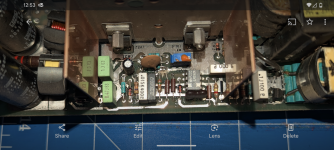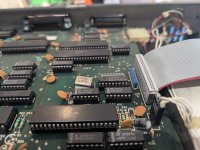Pyroteq
Member
A customer of mine gave me a Kaypro 4 '83 he had lying around. He told me that it still works, although who knows when it was turned on last.
I tried turning it on and was presented with what I can only describe as the Matrix - random characters rapidly changing filling the entire screen. I believe the power LED as well as both floppy indicator LED's were on. A few seconds later I heard a pop and saw smoke coming from the chassis, so I quickly turned it off.
Now I'm good at fixing modern computers but this thing is from before I was born, so I don't know where to start with this one. I'd like to get it running again, no idea what I'll do with it but I've always liked that luggable computer look and the monochrome CRT is pretty sweet.
I opened it up to inspect for any damage, but couldn't see anything obvious. Doing some reading it seems recommended to remove the RIFA capacitors. I removed 4 (3 small and one larger) off the Boschert power supply although from a visual inspection it wasn't obvious that any of those had been the cause of the pop and smoke but figured it was best to be safe.


After removing those caps I tried turning it on again but this time I'm just presented with a screen filled with
repeating over the entire screen.

I'm not sure if that's worse than before or an improvement. As before the power LED's and the floppy disk indicator lights were on.
I thought I remembered smoke coming from the right side of the chassis when it had made the pop sound, so I thought the next culprit may be some sort of short on the floppy drives, blown cap, etc, so I disconnected them entirely from the system and attempting to boot it again but got the same repeating 'N pattern as before.
So not sure where to go to next. Could it be a power supply issue? I could try replacing with the MEAN WELL RPT 75B I have seen recommended but I have no idea if a power supply issue would cause that sort of behaviour on boot.
There was one area of the power supply that looked a bit dodgy to me as well, I wasn't sure if it's melted solder thats caused a short of if that was scraped away during manufacture for some reason as I don't often come across PCB's this old that look hand made.


I've attached relevant pictures.
Thank you for any advice you can provide.
I tried turning it on and was presented with what I can only describe as the Matrix - random characters rapidly changing filling the entire screen. I believe the power LED as well as both floppy indicator LED's were on. A few seconds later I heard a pop and saw smoke coming from the chassis, so I quickly turned it off.
Now I'm good at fixing modern computers but this thing is from before I was born, so I don't know where to start with this one. I'd like to get it running again, no idea what I'll do with it but I've always liked that luggable computer look and the monochrome CRT is pretty sweet.
I opened it up to inspect for any damage, but couldn't see anything obvious. Doing some reading it seems recommended to remove the RIFA capacitors. I removed 4 (3 small and one larger) off the Boschert power supply although from a visual inspection it wasn't obvious that any of those had been the cause of the pop and smoke but figured it was best to be safe.


After removing those caps I tried turning it on again but this time I'm just presented with a screen filled with
'N'N'N'N'N'N'N'N'N'N
repeating over the entire screen.

I'm not sure if that's worse than before or an improvement. As before the power LED's and the floppy disk indicator lights were on.
I thought I remembered smoke coming from the right side of the chassis when it had made the pop sound, so I thought the next culprit may be some sort of short on the floppy drives, blown cap, etc, so I disconnected them entirely from the system and attempting to boot it again but got the same repeating 'N pattern as before.
So not sure where to go to next. Could it be a power supply issue? I could try replacing with the MEAN WELL RPT 75B I have seen recommended but I have no idea if a power supply issue would cause that sort of behaviour on boot.
There was one area of the power supply that looked a bit dodgy to me as well, I wasn't sure if it's melted solder thats caused a short of if that was scraped away during manufacture for some reason as I don't often come across PCB's this old that look hand made.


I've attached relevant pictures.
Thank you for any advice you can provide.












